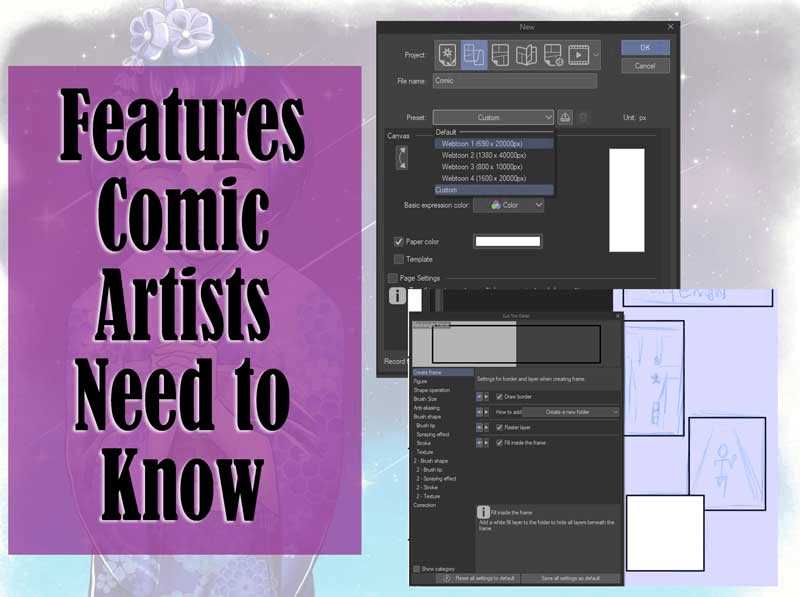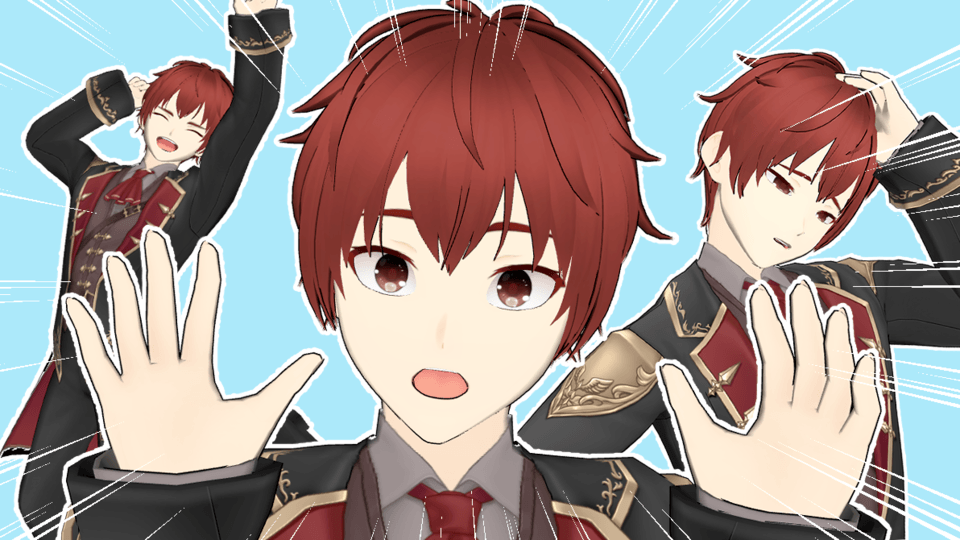tone
Selection
Selection and Tone Go Hand in Hand
It is no exaggeration to say that a selection is essential when applying a tone. Make sure you understand how to make a selection.
Quick Mask
When applying a tone to match the line drawing, it is very convenient to use the Quick Mask to check the area to which the tone will be applied in advance.
Select Quick Mask from the Selection menu. Layer Mask will be displayed in the layer palette.
Use the menu [Fill] → [Reference other layers] to fill in the necessary parts. The painted parts will be displayed in red.
If the lines are broken, use the pen tool to complete the lines. You can also use the eraser.
[POINT] The color on the Quick Mask layer can be changed by clicking [Layer Color]
If you execute [Selection] menu → [Quick Mask] again, the area that was painted red will become a selection area.
Anti-aliased line fill
If you are drawing with anti-aliased lines, there may be areas left unpainted around the lines.
In [Tool Property], set [Area Scaling] to + and set [Expansion Method] to [Expand to Darkest Pixel].
Slightly expand the area to be filled to eliminate any unfilled areas.
[POINT]
If you turn on the [Close Gap] option of the [Fill] tool, it will ignore the small gaps between the lines and fill. It is for "small gaps" so it cannot be used for large gaps. Please use it as a kind of talisman.
Quick Mask to Selection
Once you have filled in the area you want to apply the tone to, go to the menu [Selection] → [Quick Mask] again...
The area will be selected. Proceed to the next step of applying the tone.
If you run [Quick Mask] again, the selected area will return to being filled in red.
tone
Krista's tone
All images drawn on Clip Studio Paint can be treated as tones by turning on [Tone] in the layer properties and screened. Not only photographs, but also drawings you make yourself with watercolor brushes can be toned as they are.
[POINT]
Tone in Clip Studio Paint is set in [Effect]-[Tone] in [Layer Properties] for any image or layer.
Create a tone layer and apply a tone (simple tone setting)
Click the [New Tone] button in the selection launcher that appears when you create a selection.
You can also do the same thing by executing [Layer]->[New Layer]->[Tone] from the menu.
In the displayed [Simple Tone Settings] dialog,
- Number of lines (fineness of the tone mesh, such as 60 lines or 65 lines)
- Density (gray density, such as 5%, 10%, 15%, or 20%)
- Type (for halftone dot tones, [Circle]; for line tones, [Line]; for grain noise tones, [Noise])
- Angle (45 degrees is generally used unless otherwise specified)
- Size (for noise tones, set the size of the noise)
- Coefficient (for noise tones, set the length of the noise)
[POINT]
[Merge tones with the same settings into one] ON tones with the same settings will be merged into one.
Applying tones from the material palette
Drag and drop the material from the material palette onto the layer list to paste the material.
If the material is compatible with tones, you can use it as a tone as is. If it is not halftone-converted, turn on [Tone] in the layer properties to convert it to a tone.
Tone processing
Checking the tone layer
Clicking [OK] in the simple tone settings will create a "solid color" layer with [tone] set to ON.
The roles of the icons on the layer list are as follows.
① Solid color layer icon
② Layer mask
③ Tone frequency and density
...is displayed
Tone Scraping/Bleaching
If you have toned the [Solid Color] layer, you can erase/fill in the tone with the [Layer Mask] selected.
- Eraser Tone
→ Set the color of the eraser tool or brush tool to [Transparent] and draw.
- Add tone
Set [Color] to [Black] and draw with the brush tool.
Tone blurring (analog style)
[Decoration] subtools[Hatching/Sand] → [Hatching (for tone scraping)] and [Sand (for tone scraping] can be used to express blurring and scraping.
If the tone density is too high (40% or more), the brush shape will be noticeable, so be careful.
https://assets.clip-studio.com/ja-jp/detail?id=2000177
Tools that allow for more natural blurring and scraping are available on ASSETS and other sites.
Tone blurring (digital style)
I will show you how to smoothly erase tones using the [Soft] sub tool of [Eraser].
Complete the following settings in [Layer Properties]
- Select the [Masked Image] effect range
- Set the [Gradation] mask expression to [Yes]
You can see how the tone gradation changes smoothly with the size of the dots, not with the opacity. For monochrome manga manuscripts, setting [Effect range]-[Masked image] will help avoid problems when printing.
Shifting the mesh tones
To layer two tones with the same frequency and shift the dots, use the [Move Layer]-[Move Tone Pattern] subtool.
When you drag on the canvas, only the position of the halftone dots moves. The position of the tone area (layer mask) does not change.
[POINT]
The [Tone Pattern Move] subtool is the [Layer Move] tool property setting for [Tone Dot] as [Move Target].
Tone settings list
I want to erase it softly using the gradation tool.
It is easier to express a gradient if the mask itself has a gradation.
→ Set [Mask expression]-[Gradation] to [Yes] to enable the gradation of the mask.
Specify the tone density in %
If you want to specify the density as a percentage, such as "60 lines 10%"
->[Density]-[Use specified density] → Set the numerical value (solid color layer)
I want to reflect the layer opacity in the tone.
For example, you can set the opacity of a layer painted completely black to 10% or 20% to create a tone.
-> Set [Reflect Layer Opacity] to ON
Tone creation example
Characteristics of Tone Layer (Solid Color Layer)
- Advantages
The tone (gradation) layers created with [Simple Tone Settings] can be adjusted for each tone, making it easy to change the shading and density.
- Disadvantages
The number of layers increases with each type of tone, making management and settings more complicated.
Grayscale Layer Features
- Advantages
Because you draw with a drawing tool on a raster layer (expression color gray). More complex shading can be expressed. Even if the number of gradation patterns increases, they can be expressed on a single layer.
- Disadvantages
Since you cannot set individual settings for each type of tone, corrections/changes become complicated.
[POINT]
If you want to use effects that use blending modes on multiple layers, select the folder that contains the layers and set [Layer Properties] → [Effects] → [Tone] effect to ON
Example of effect (night drawing)
If you want to create an overall dark tone, it's easier to create a dark atmosphere by simplifying the composition with a single type of gradation.
In this example, the dark accents on the left window and the moonlight coming in through the right window are expressed by removing the tones.
The [Align] function is useful for regularly-spaced window shapes.
The light coming in illuminates the floor, and the flat window shapes are given perspective using [Free Transform].
Examples of shortcuts for leaving areas unfilled
Quickly address areas that have not been painted
With the [Fill] tool selected, try changing the contents of [Modifier Key Settings] → [Cmd/ctrl] from the [File (or CLIP STUDIO)] menu.
Set it so that you can quickly switch between fill tools and quickly fill in small unfilled areas.
Apply to the remaining areas.
→ [Temporarily change tool]-[Paint unpainted areas]
For monochrome line drawings, [Paint unpainted areas] is more efficient. With line drawings that have anti-aliasing turned on, it may not be possible to paint over unpainted areas sufficiently.
Lasso painting
→ [Temporarily change tool] - Lasso painting subtool
This tool is easy to use with line drawings that have anti-aliasing turned on.
























Comment